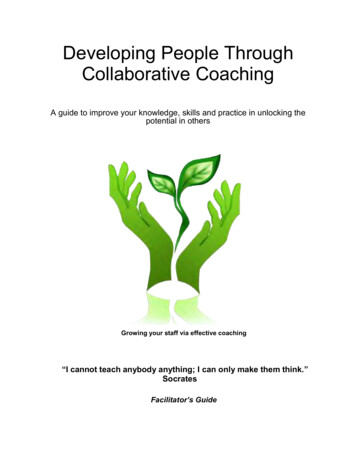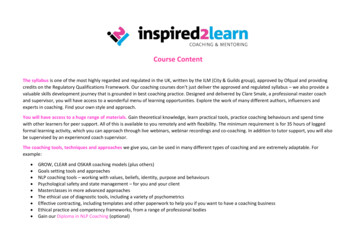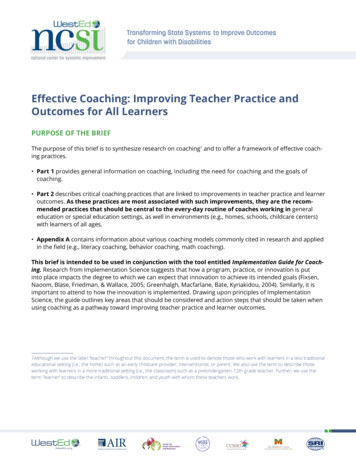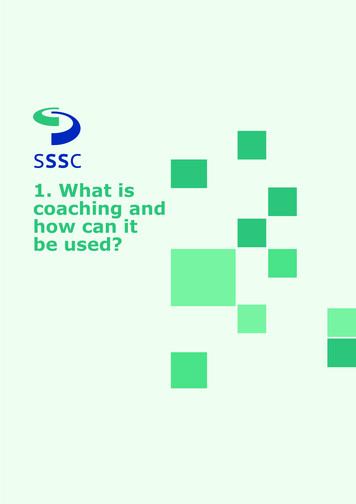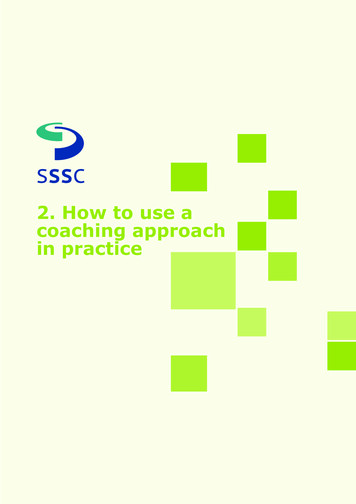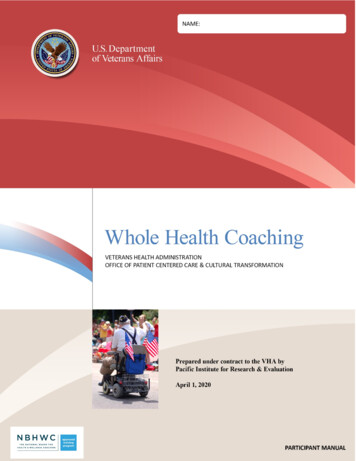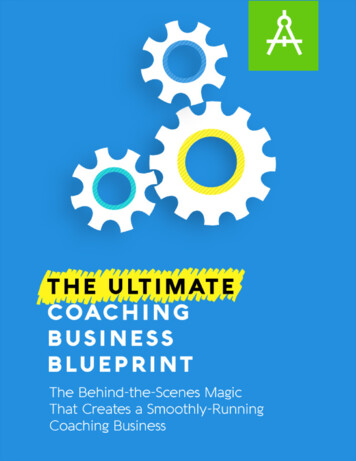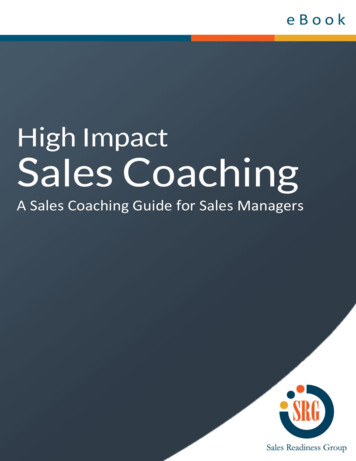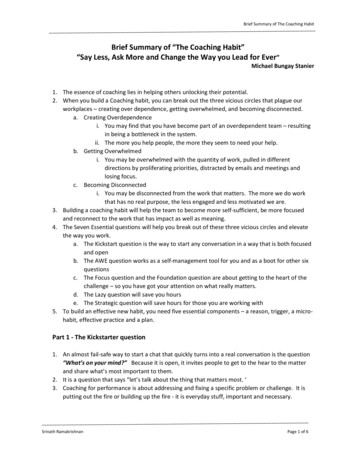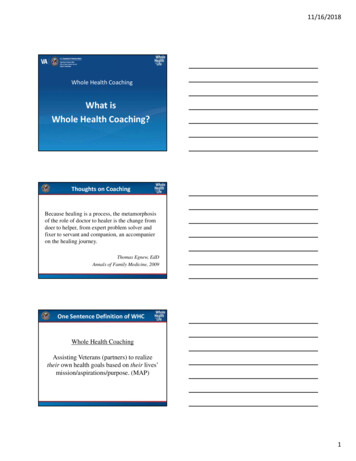
Transcription
11/16/2018Whole Health CoachingWhat isWhole Health Coaching?Thoughts on CoachingBecause healing is a process, the metamorphosisof the role of doctor to healer is the change fromdoer to helper, from expert problem solver andfixer to servant and companion, an accompanieron the healing journey.Thomas Egnew, EdDAnnals of Family Medicine, 2009One Sentence Definition of WHCWhole Health CoachingAssisting Veterans (partners) to realizetheir own health goals based on their lives’mission/aspirations/purpose. (MAP)1
11/16/2018Two Distinguishing Features of WHC The belief behind [integrative] healthcoaching is that behavior changes aresustainable when linked to personal valuesand sense of purpose.Caldwell, K., Gray, J. & Wolever, R. (2013). The process of patient empowerment in integrative healthcoaching: How does it happen? Global Advance in Health and Medicine, 2 (3), 48 – 57.Two Distinguishing Features of WHC Patients bring to the coach information andrecommendations from their treatmentproviders and work with the coach to decidewhich ones to enact and most importantlyhow to do so in a way they can sustain givenall they know about their lives.Caldwell, K., Gray, J. & Wolever, R. (2013). The process of patient empowerment in integrative healthcoaching: How does it happen? Global Advance in Health and Medicine, 2 (3), 48 – 57.VIDEOThe American Veteran—Integrative Health Coachinghttps://youtu.be/JSTkaFTO7f82
11/16/2018Characteristics of Health Coaching1. Strength‐focused.2. Views the client as competent (Sharedexpertise).3. Aspiration focused – may be eliminating aproblematic area or enhancing a positivefocus.4. Generally, present and future focused.5. Individual, group, telephonic.What is Whole Health killsUsing the 4 Stage Coaching ProcessHEALTH COACHING PROCESS MODELStage IVExecutetheActionStage IIIPlanforActionTake furtheraction.Re-plan.Learn lessons.Assess action.Create vision.Explore valuesandvalue conflicts.Goals & Actions.Explore barriers.Training &Support.AccountabilityConduct PHIassessment.Define focus.Assessreadiness.Stage IExploreMissionAspirationsPurposeStage IIReflect,Assess &Focus3
11/16/2018Whole Health CoachingQualities of a CoachRespectfulIs PresentMindfulListensUses a Guiding StyleIs a PartnerArticulate &Succinct Willing to Learn Is Open Is Empathic Coaching StrategiesCommunication Skills Uses Inquiry for Open &Close Ended Questions Uses Simple Reflections ofparroting, paraphrasingand summary Uses Complex Reflectionsthat are double‐sided andhave deeper meaning,values Uses Direct Statements toprovide information andguide the process, using Istatements Develops MAP,explores values,guides futurevisioning Assesses componentsof health using PHI,selects a focus area,assesses importanceand confidence Set SMART Goals andAction Steps, explorebarriers, contingencyplans, and resources Explore perspectivesCoach QualitiesRespectful – honors the unique agenda,resources and ‘inner wisdom’ of anotherPresent – fully available for the otherMindful – demonstrates Jon Kabat‐Zinn’s 7Attitudes of MindfulnessBeginner’s Mind Non‐JudgingStriving AcceptancePatienceNon‐Letting Go TrustCoach QualitiesListener – set aside own agendas to fully listen to theother Not a ‘teller’ – not inclined to give advice orinstruct/educate the otherGuiding style – guides the process, but does direct theagenda, outcomes nor strategies Not a directing stylePartner – goes along side the other on their journey Not an ‘expert’4
11/16/2018Coach QualitiesArticulate and succinct – is clear and succinct incommunication styleWilling to learn / OpenEmpathic – seeks to fully understand and bepresent with the experience of anotherInterest in health enhancement and education – isnot necessarily an ‘expert’ in all areas of health butvalues health enhancement and educationCoaching Strategies Develop Mission, Aspirations and Purpose(MAP) Explore values and value conflicts Guide future visioning Assess components of health utilizing PHI Select a focus area Assess importance of focus in light of MAP Assess/enhance confidenceCoaching Strategies Set SMART goals (in light of MAP) Set SMART action steps (in light of goal) Explore strengths Explore barriers and contingency plans Explore resources and support Establish accountability Assess lessons learned5
11/16/2018Coaching Strategies Explore and develop perspectives Reassess/re‐establish action steps, goals, focus area,MAP Utilize elicit, provide, elicit to respectfully provideinformation Conduct brainstorming Guide basic group processes Lead mindfulness activities Direct/redirect coaching processFor Whom is Health Coaching Appropriate? A self‐motivated Veteran who is seeking support. A Veteran referred by clinical team or provider. Motivation may vary; coach may need to assistVeteran in determining motivation. Assessing the coach/client fit and referring theVeteran to another provider.17th Century Nun’s PrayerKeep me from the fatal habit of thinking I mustsay something on every occasion.Release me from craving to straighten outeverybody's affairs.Make me thoughtful but not moody; helpful butnot bossy.(Continued .)6
11/16/201817th Century Nun’s PrayerWith my vast store of wisdom, it seems a pitynot to use it all, but I want a few friends at theend.Keep my mind free from recitals of endlessdetails; give me wings to get to the point.Give me the ability to see good things inunexpected places, and talents in unexpectedpeople. And, give me, the grace to tell them so.Whole Health CoachingParticipant ManualParticipant Manual7
11/16/2018AgendaWelcome and IntroductionThe Manual Does not follow the lectures More like a textbook Designed to complement thecourse8
11/16/2018Additional Course Material Beginning on pg. 73 – find the OPCC&CTlink to the SharePoint site to downloadPowerPoint slides Information about the Office of PatientCentered Care & Cultural Transformation Links to course videos and more thatmight be helpfulResources and References OPCC&CT – pg. 76‐77 Resources to support your WholeHealth journey – pg. 78 Other VHA resources and suggestedwebsites pg. 78‐79Handout SectionPgs. 1-11 ThePersonal ARE/about.aspResources – My Story9
11/16/2018OPCC&CTOffice of Patient Centered Care and Cultural e/index.aspWhole Health CoachingIntroduction toMindful AwarenessMindful AwarenessWhat does being presentmean to you?10
11/16/2018Mindful Awareness“Paying attention on purpose,in the present moment,non-judgmentally.”Jon Kabat-Zinn, PhDMindful Awareness“The intention to pay attention,in the present moment, with afriendly and open orientation.”Jeff Brantley, M.D.11
11/16/2018Mindful AwarenessWe all have it . . .the natural capacity topay attention with curiosityand openness.Mindful AwarenessWe also have the capacityfor mindlessness,in-attention, or going onauto-pilot.Mindful Awareness“Mr. Duffylived a shortdistance fromhis body.”James Joyce12
11/16/2018Mental Benefits of Mindful AwarenessLess emotional distress and ruminationDecreased anxiety, worry, anger,depressionIncreased concentration, emotionalintelligence, creativity and problemsolvingPhysical Benefits of Mindful AwarenessDecrease in stress hormonesDecrease in heart rate, blood pressure,and hypertensionDecrease in inflammatory moleculesDecrease in chronic painIncrease in immune functionBehavioral Benefits of Mindful AwarenessIncrease in non-reactivitySmoking cessationDecrease in binge eatingDecrease in sleep disturbanceReduction in alcohol use and illicitsubstance use13
11/16/20187 Attitudes of Mindful JudgingLettingGoAcceptanceTrustPractice of Mindful Awareness Find a comfortable positionAllow your eyes to close if you likeRemember the 7 attitudesLet go of busy-ness or life concernsPay attention to your breathWhen attention wanders to thought, sensation,emotion, etc. . . . simply notice Gently return focus to your breath Practice as long as you wishMindful Awareness“We shall not cease fromexploration. And the end of all ourexploring will be to arrive wherewe started and know the place forthe first time.”T.S. Eliot14
11/16/2018Mindful Awareness“Life moves pretty fast. If youdon't stop and look around once ina while, you could miss it.”Ferris BuellerWhole Health CoachingWhole Health andPatient Centered CareVHA Strategic GoalsObjectives for 2013‐2018Provide Veterans personalized,proactive, patient‐driven health careand support to successfully implementtheir personal health plans.15
11/16/2018VIDEOVIDEO: Tracy Gaudet—Personalized,Proactive, Patient‐Driven Care(Video link available on Sharepoint)Personalized, Proactive, Patient‐DrivenPERSONALIZEDA dynamic adaptation or customization of recommended education,“Tailorcare relevant to the individual user,prevention and treatmentthat is myspecificallybased on the user’s history,presentation, lifestyle, behavior andto meclinicalas a person”preferences.PROACTIVEActing in advanceof a preventlikely futuresituation, rather than just reacting; taking“Help mefutureinitiative to make things happen rather than just adjusting to a situation orandtopreparefor anywaitingproblemsfor somethinghappen. Usingstrategies that strengthen theperson’scapacityfor healthandhealing,such as mind‐body approacheshealthproblemthatcomesup”prior to surgery.PATIENT‐DRIVENAn engagement between a patient and a health care system where thewhathealth care is based in theirpatient is the source“Supportof controlmesuchwiththat theirneeds, values, and howthe patientto live. This requires that wemattersmostwantsto me”change the conversation and start from a different place.Mentalhealth.va.govQuestions for PCC Consideration1. Think of a time when you or a loved one receivedwhat you believe was ‘patient‐centered’ care.2. What did the provider say or do that made it amemorable patient‐centered experience?3. How was it either:a. Patient‐driven?b. Personalized?c. Pro‐active?16
11/16/2018Whole Health CoachingListeningMindful CommunicationPractice #1Mindful Speaking & Listening Speaker: Share a decision you are currentlymaking, or have made in the past. Listener: Bring your attention to your partner’swords.17
11/16/2018Practice #2Mindful Speaking & Listening Speaker: Talk about an area of your life whereyou’re considering making a change. Listener: As you listen, notice your own innerexperience (body sensations, thoughts,emotions)Practice #1 and #2 DebriefWhat did you notice?Listening Being present allows us to listen Listening involves paying attention towhat our client/partner is saying or notsaying, both verbally and non‐verbally,the feeling and meaning behind thewords.18
11/16/2018Coaching Quality: Listening/EmpathyAs you watch the video Bring a mindful attention toyour thoughts, feelings,reactionsVIDEOEmpathy—The Human Connection toPatient Care (Cleveland Clinic)https://youtu.be/cDDWvj q‐o819
11/16/2018Partner ActivityBased on the video you just watched: Each person will share a response to thevideo. The speaker will have 2 minutes. The role of the listener is to be present andlisten without responding. Simply ‘hold thespace’ for your partner to share.Listening/Empathy Activity Questions1. What was it like just to listen?2. What was your experience beinglistened to without interruption?3. How does listening relate toempathy?Listening How can you tell if someone is reallypaying attention and listening to you? When are times when you don’t listenwell? What gets in your way of listeningwell?20
11/16/2018Two Types of Listening Primarily Self‐focused Primarily Other‐focusedSelf‐Focused Listening Multi‐task, distracted Formulate responses Filter through past experiences, history,assumptions Personal stories, agenda, advice21
11/16/2018Other‐Focused Listening Beginner’s Mind, Not‐knowing Attention to body language, facialexpression, tone of voice Attuned to energy and emotions behindthe words Allow for silence, space, pauseThe Pause“The PAUSE: that impressivesilence, that eloquent silence,. . . which often achieves adesired effect where nocombination of words. . . couldaccomplish it.”Mark Twain22
11/16/2018Listening Questions1. If time or money were no issue, whatwould you be doing with your life?2. Think about one or two people whoinspire you. What about them isinspiring?3. What parts of your current job or lifeactivities do you enjoy most?VIDEOIt’s Not About the Nailhttps://youtu.be/‐4EDhdAHrOgWhole Health CoachingOverview of the Whole Health CoachingProcess Model23
11/16/2018COACHING PROCESS MODELStage IVExecutetheActionStage IIIPlanforActionTake furtheraction.Re-plan.Learn lessons.Assess action.Create vision.Explore valuesandvalue conflicts.Goals & Actions.Explore barriers.Training &Support.AccountabilityConduct PHIassessment.Define focus.Assessreadiness.Stage IExploreMissionAspirationsPurposeStage IIReflect,Assess &FocusWhole Health CoachingHealth Coaching Process Model ‐Stage I, Phase 1Mission/Aspiration/PurposeExercise (MAP)1. What were some dreams/aspirations you hadwhen you were younger?2. Are you in any way currently living out thosedreams/aspirations? If so, How?3. What are some aspirations/dreams you have foryourself in the future?4. What do your dreams/aspirations tell you aboutwhat is important to you now (values)?24
11/16/2018Developing a Personal Mission (MAP)and Creating a VisionOne Way to Start a ConversationA Different Way to Start a Conversation “What’s the matter?” “What matters most?” “What concerns youabout your health?” “What do you want yourhealth for?” “What are yourproblems today?” “What is your vision ofyour best possiblehealth?”Developing a Personal Mission (MAP)and Creating a VisionDeveloping a Personal Mission (MAP)and Creating a Vision“The future vision of VA healthcaretransforms the organization from aproblem-based disease care systemto one that is patient centered andfocused on [your] whole health.”25
11/16/2018Developing a Personal Mission (MAP)and Creating a Vision“You ought not to attempt to cure the eyeswithout the head or the head without thebody, so neither ought you attempt to curethe body without the soul.for the part cannever be well unless the whole is well.”PlatoDeveloping a Personal Mission (MAP)and Creating a VisionWhole Health“Living life fully and optimizing healthand well‐being goes beyond not beingsick; it means understanding whatmatters to you and looking at all aspectsin life that contribute to a sense of well‐being.”Developing a Personal Mission (MAP)and Creating a VisionThe Components of ProactiveHealth And Well‐BeingAlso called:The Circle of Health26
11/16/2018Developing a Personal Mission (MAP)and Creating a VisionDiscovering Why.“You are the expert on you! The firstand most important step in creating yourroadmap to your healthiest life is to stepback from your health concerns. Whatreally matters to you? Why do you wantor need your health?”Developing a Personal Mission (MAP)and Creating a VisionYour Personal Health Inventory1. What REALLY matters.?2. What brings you joy/happiness?3. On the following scales. Physical Well‐Being Mental/Emotional Well‐Being Day‐to‐day life?27
11/16/2018Developing a Personal Mission (MAP)and Creating a VisionAdditional MAP Questions1. What do you see yourself doing in 3-5 yearsif you are healthy and happy?2. What were your aspirations when you wereyounger? What are they now?3. What do you need/want your health for?4. What is my mission, aspiration, mypurpose for my life?VIDEODream Rangers—What Do You Live For?https://youtu.be/bp7S56aoIhUDeveloping a Personal Mission (MAP)and Creating a VisionYour Personal Health Inventory1. What REALLY matters.?2. What brings you joy/happiness?3. On the following scales. Physical Well‐Being Mental/Emotional Well‐Being Day‐to‐day life?28
11/16/2018Instructions for MAP Activity Turn to the Personal Health Inventory (PHI)on page 5 of Handout Section. Complete questions 1‐3. You will have 10minutes to reflect and complete.Certification ProcessNational Board CertifiedHealth & Wellness Coach(NBC‐HWC)NBC‐HWC CertificationInternational Consortium For Health andWellness Coachinghttps://ichwc.orgWhole Health Coaching accepted December2015 as Approved Transitional Program29
11/16/2018WHC Requirements Course completion—complete all hours ofthe 2 session training Participation in all triad/quad coachingpractices (in training and interim) Certificate of completionNBC‐HWC Certification ICHWC Requirements Successful completion and certificate from anICHWC accepted training/course Educational and documentation requirements 50 documented coaching sessions logged—groupsand individuals AFTER receiving final course evaluation Coaching log available on ICHWC website—withinstructions for confidentiality Exam fee 450NBC‐HWC CertificationWHC Certification Process PASSING Final Evaluation is compiled from all observedcoaching practices 30‐day process—notification and documentationwill be sent within 30 days Final Evaluation, Certificate, and formal letterfrom Dr. David Rychener Kelly Howard, at the OPCC, will be notified30
11/16/2018NBC‐HWC Certification PROVISIONAL PASS– Not a fail—this means, at this time, our evaluations reflect aneed for more practice– Notification within 30 days– Final Evaluation—with areas of strengths and opportunitiesfor improvement to work on– Gain some practice—practice coaching skills and strategies– Contact Bobbie Bruner‐Muirhead, WHC Site Coordinatorand Kelly Howard to apply for a re‐evaluation with coaching31
Whole Health Coaching Listening Mindful Communication Practice #1 Speaker: Share a decision you are currently making, or have made in the past. Listener: Bring your attention to your partner’s
